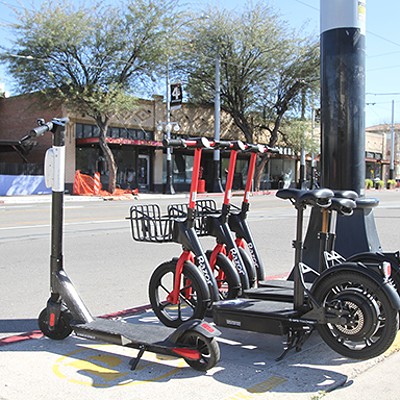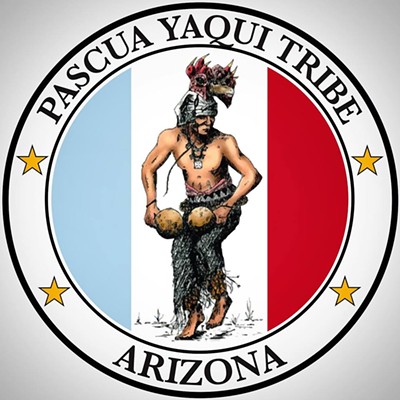It's not uncommon for Susan Scherl to find skinny dogs or unwanted kittens dumped outside her HOPE Animal Center in midtown Tucson.
Like other rescue outfits across town, HOPE absorbs these little surprises by stretching its already meager budget just a little thinner. That's why Scherl was flabbergasted recently when the Tucson City Council groused over pitching a mere $150,000 to the county's struggling spay and neuter program.
That program, currently budgeted at $220,000, has saved an estimated 173,000 animals from being born and potentially winding up outside HOPE's doors, or on the business end of a euthanasia needle at the Pima Animal Care Center.
"I think it's a shame the City Council won't put more money toward saving lives," she says, "because that's exactly what having low-cost or free spay and neuter would do."
Cutting the number of unwanted animals has become a crusade for Ward 6 City Councilman Steve Kozachik, who raised the issue at the council's Sept. 10 study session. "It's not as if we can pretend the problem doesn't exist just because we don't want it to exist," Kozachik said in a follow-up interview. "And I do not accept the argument from some other council members that we don't have money in the budget."
Among the study session grumblers was Mayor Jonathan Rothschild. "Clearly, it's a good project, and it's hard to argue against puppy dogs," Rothschild said, before decrying its potential impact on city coffers.
Maybe it's just a matter of priorities. Consider the law firm Mesch, Clark & Rothschild, which Mayor Rothschild's father helped create, where the mayor's son continues to practice, where the mayor himself was part owner until taking office, and which perennially plumps itself on fat city contracts.
Though Mayor Rothschild likes to say his family firm has saved the taxpayers "hundreds of millions" of dollars by defending the city in lawsuits, he certainly hasn't squawked about the millions it continues to gobble from the public trough.
In fiscal year 2012-2013, which ended June 30, the city paid $178,153 to Mesch, Clark & Rothschild for legal services. The year before, that sum was $470,766, or more than triple Councilman Kozachik's proposed contribution to the spay and neuter fund.
Perhaps you might also consider operating costs for the modern streetcar, potentially topping $4 million annually, or 26 times the additional spay and neuter funding. Then there's the new elephant exhibit at Reid Park Zoo, which cost taxpayers more than $4 million to build. Another $400,000 will be spent each year to maintain it for five elephants. That's approximately $80,000 per elephant.
The cost of fixing a dog or cat runs around $70.
Others look back to 2009, when the county hiked dog license fees from $12 to $15, and steered the additional $3 to a spay and neuter program run by the Animal Welfare Alliance of Southern Arizona. The city pays the county about $3.5 million to handle animal services, and receives approximately $1.1 million back from licensing revenues. But instead of mimicking the county by sinking that extra $3 into spay and neuter efforts, the city simply keeps its share.
This occurs under a fee-for-services agreement; at year's end, the city pays for any services beyond the $3.5 million already allocated. That's where Kozachik hopes to insert the additional $150,000 spay and neuter funding. But a motion passed at the Sept. 10 meeting only sent city staff to find a "revenue-neutral" way for covering the cost.
To PACC manager Kim Janes, that hints at the city squeezing his budget to foot the bill. "It's a fee-for-service contract, so you pay for what you ask for," he says. "I don't see in my mind how that would work. But I'm open to discussion with the city, and they may have some other ideas."
Crunching the numbers raises a few notions worth pondering. In fiscal year 2012-2013, for instance, PACC received more than 23,600 animals, and euthanized more than 10,000 of them.
Of that 23,600 total, more than half—or 14,638—came from within Tucson. Of those, 5,592 were killed by county staff.
Of the dogs and cats arriving from the city, the largest number—3,595—came from Ward 5, represented by Councilman Richard Fimbres. Of those, 1,340 were euthanized.
A close second was Ward 1, represented by Councilwoman Regina Romero, with 3,476 total animals and 1,154 euthanizations.
The fewest intakes and euthanizations, 1,174 and 465 respectively, came from Councilman Paul Cunningham's Ward 2. In between was Councilwoman Karin Uhlich's Ward 3, with 3,208 animal intakes and 1,434 euthanizations. Councilwoman Shirley Scott's Ward 4 followed with 1,449 intakes and 521 euthanizations. Ward 6, represented by Councilman Kozachik, contributed 1,736 total animals and 678 euthanizations.
Beyond that grim body count, say critics, is pure cost-effectiveness.
K.C. Theisen is director of Pet Care Issues for the Humane Society of the United States in Washington, D.C. She points to New Hampshire, which implemented a statewide, low-cost spay/neuter program in the 1990s. "A study found that for every $1 they invested in a spay and neuter fund," Theisen says, "they were saving approximately $3.15 in reduced costs of housing and possibly euthanizing animals."
Research in neighboring New Mexico showed that "out of a $27 million budget for animal care agencies across the state, $12 million goes toward sheltering animals that don't exit the shelter alive," she says.
"That's about $12 million spent on cats and dogs that were ultimately euthanized. Compare that to the cost of spay and neuter programs, which was about $2.5 million a year."
According to the advocacy group No Kill Pima County, an effective, low-cost spay and neuter program is also key to reducing PACC's current euthanasia rate, officially pegged at 36 percent. "It's not the only element," says Marcie Velen of No Kill, "but it's huge."
Unfortunately, Tucson isn't alone in being stingy. Responding to a plea from Pima County Administrator Chuck Huckelberry for more spay and neuter funding from local communities, Sahuarita Town Manager L. Kelly Udall replied that his council members have directed staffers to "hold the line and minimize fee increases for the last few years."
Meanwhile, dogs and cats continue arriving at shelters like HOPE, which must turn their meager resources toward sterilizing animals these cities won't pay to fix. "We see so many that are not spayed or neutered," says Scherl. "It puts the onus on the shelter and rescue groups—who are not loaded with money—to have to go out and spend the money to have them spayed and neutered. It's a big part of the cost of rescue."












